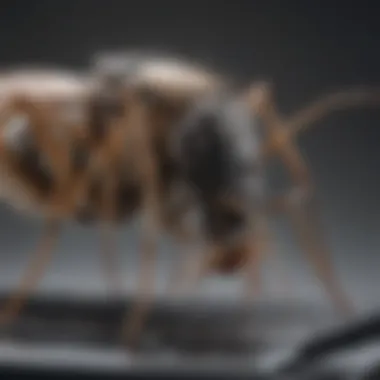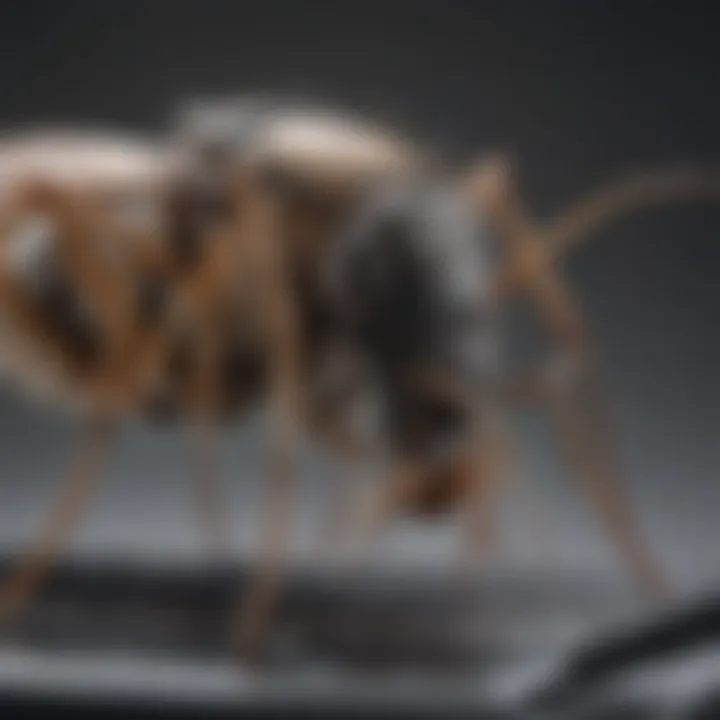Commercial Mosquito Magnet: An In-Depth Examination


Intro
Mosquito control is a significant concern for many homeowners, especially during warmer months. These pests not only disrupt outdoor activities but can also carry diseases. The need for effective solutions has led to the development of various devices, most notably the commercial mosquito magnet. This article aims to provide a thorough examination of how these devices operate, their effectiveness, and their ecological implications.
Understanding the behavior of mosquitoes is key. Mosquitoes are attracted to carbon dioxide and body heat. The mosquito magnet aims to replicate these signals, drawing them in. However, to properly manage these pests, one must first grasp the larger context of pest management.
Understanding Pests
Definition of Pests
Pests are organisms that cause harm to crops, livestock, or humans. They often compete with us for resources and can create significant disruptions in daily life. Mosquitoes fall firmly in this category due to their nuisance behavior and potential health risks.
Importance of Pest Identification
Identifying the specific type of pest is crucial for implementing appropriate control methods. Mosquitoes, for instance, belong to various genera, such as Aedes and Culex. Understanding their behaviors and habitats assists in choosing the right management strategy. By recognizing which mosquito species are prevalent in your area, you can tailor your approach effectively.
Prevention Techniques
Home and Garden Preventative Measures
While mosquito magnets can be an effective tool, prevention should start at home. Here are several strategies:
- Remove standing water: Mosquitoes breed in stagnant water. Regularly check areas like bird baths, clogged gutters, and plant saucers.
- Maintain your garden: Trim overgrown vegetation, where mosquitoes like to hide. Keeping your yard tidy limits their resting areas.
- Use screens on windows and doors: Barriers can stop mosquitoes from entering your home.
Seasonal Prevention Tips
Different seasons bring varied mosquito activity. During warmer months, increase the frequency of preventive measures, while in colder months, focus on ensuring your property is well-maintained to avoid any breeding opportunities once temperatures rise again.
Eco-Friendly Pest Control Solutions
Overview of Sustainable Practices
As concern for the environment grows, many people are exploring eco-friendly pest control. Several practices can help manage mosquito populations without harmful chemicals:
- Encourage natural predators: Birds, bats, and certain insects help control mosquito numbers naturally.
- Plant mosquito-repelling plants: Basil, lavender, and marigold not only enhance your garden but also deter mosquitoes.
Natural Remedies and Their Effectiveness
While natural remedies may vary in effectiveness, some individuals have found success:
- Essential oils: Oils such as citronella and eucalyptus can repel mosquitoes when applied topically or diffused in the air.
- Garlic: Some anecdotal evidence suggests that consuming garlic may deter mosquitoes due to its scent.
"Integrated pest management combines prevention, monitoring, and control. It is a holistic approach to pest control that takes into account the entire ecosystem."
Prelude to Commercial Mosquito Magnets
In recent years, commercial mosquito magnets have emerged as a crucial tool for managing populations of these pests. Understanding how these devices operate and their role in pest control can offer valuable insights for homeowners, gardeners, and anyone interested in minimizing mosquito intrusions. This section aims to shed light on the definition and purpose of commercial mosquito magnets, as well as their historical background and evolution.
Definition and Purpose
A commercial mosquito magnet is a device designed primarily to attract and capture mosquitos. It works by mimicking the natural cues that draw these pests to humans, such as carbon dioxide and body heat. By effectively reducing mosquito numbers, these gadgets enhance outdoor experiences by creating more pleasant environments for activities like barbecues, gardening, or simply enjoying the fresh air.
The overarching purpose of these devices goes beyond immediate comfort; they represent a step towards integrated pest management, combining various strategies to address mosquito populations sustainably. Many users appreciate the non-chemical approach these devices offer, aligning with a growing concern for health and environmental safety.
Historical Background
The concept of using attractants to manage pests is not new. Traditional methods date back centuries, but advancements in technology have significantly refined the process. Early contraptions relied on simple designs that utilized light or scent, which had limited effectiveness. The commercial mosquito magnet gained traction in the late 20th century as understanding of mosquito behavior improved.
Research highlighted the importance of carbon dioxide in attracting mosquitos, leading to innovative designs that incorporated this knowledge. Over time, manufacturers have developed more sophisticated models, enhancing both their functionality and appeal. Now, commercial mosquito magnets are commonly found in residential and commercial spaces alike, reflecting the increasing demand for efficient pest control solutions.
Mechanics of Operation
Understanding how commercial mosquito magnets work is essential for evaluating their effectiveness. The functioning primarily hinges on two key components: the attractants used and the trapping mechanism. These elements directly impact the performance of these devices in controlling mosquito populations. By comprehending these mechanics, users can determine the best model suited for their specific needs.
Attractants Used
Attractants are critical to drawing mosquitoes into the trap. The effectiveness of a mosquito magnet relies on how well these attractants mimic the natural cues that entice mosquitoes to humans.
Carbon Dioxide
Carbon dioxide is a primary attractant because it aligns closely with the cues mosquitoes seek. When humans exhale, they release carbon dioxide, signaling the presence of a possible host. This makes carbon dioxide a beneficial choice for this article.
One unique feature of carbon dioxide is its ability to cover a considerable area. Mosquito magnets can generate or release carbon dioxide in volumes that can attract mosquitoes from distances. However, one disadvantage is that it can be less effective when multiple competing sources of CO2 are present, such as nearby humans or animals.
Heat Emission
Heat emission is another pivotal component. Mosquitoes are drawn to heat, which indicates the presence of a warm-blooded host. This makes heat a popular choice among attractants in these devices. During operation, the devices simulate body heat by emitting warmth, effectively luring mosquitoes closer.
The distinct characteristic of heat emission lies in its short-range attraction. While it can be effective in close proximity, its efficacy decreases significantly with distance. This requires users to consider placement carefully, ensuring optimum results in mosquito management.


Odor-Based Lures
Odor-based lures also play a significant role in this context. They often consist of synthetic compounds that replicate human scent or other natural odor sources that attract mosquitoes. This option is beneficial as it taps into the olfactory senses of mosquitoes.
A unique feature of these lures is their targeted appeal. Specific formulations can be tailored to attract certain mosquito species more effectively. However, a drawback is that the effectiveness of these lures can diminish over time, requiring periodic replacements to maintain optimal performance.
Trapping Mechanism
The trapping mechanism is designed to capture mosquitoes once they have been attracted. This aspect is equally vital in maximizing the effectiveness of a commercial mosquito magnet.
Vacuum System
A vacuum system is commonly utilized in many mosquito traps. Once mosquitoes are drawn in, this system creates a suction that pulls them into the trap. The key characteristic of such a system is its efficiency in quickly capturing mosquitoes.
One distinct advantage is that it reduces the chance of escape, ensuring a higher capture rate. However, one should consider that the operational noise could be a minor nuisance, affecting its use in quiet residential areas.
Adhesive Panels
Adhesive panels serve another trapping method, using sticky surfaces to catch mosquitoes. They are a popular choice because they require no power source and are simple to use.
An advantage of adhesive panels is their low maintenance. Once mosquitoes land on these panels, they cannot escape. However, their effectiveness can be limited by external factors such as rain, which can diminish their sticky surfaces.
Collection Baskets
Collection baskets provide a straightforward mechanism whereby captured mosquitoes accumulate in a designated area. They can be effective as a secondary trapping method. The key characteristic is their ease of use and disposal.
Users can conveniently empty these baskets and eliminate captured mosquitoes. However, one must consider that they require regular monitoring and disposal to prevent re-infestation of the area.
Effectiveness of Commercial Mosquito Magnets
Understanding the effectiveness of commercial mosquito magnets is crucial for anyone seeking to eliminate these pests efficiently. These devices aim to lower mosquito populations, making outdoor environments more comfortable, especially during warm months. The effectiveness is not solely based on the device itself but also hinges on various external factors. By exploring the details related to their performance compared to traditional methods, we can draw meaningful conclusions that impact both homeowners and commercial users.
Comparative Analysis with Other Methods
Chemical Sprays
Chemical sprays have long been a go-to solution for many homeowners. They work by dispersing insecticides into the air, targeting mosquitoes directly. The key characteristic of chemical sprays is their ability to provide immediate relief from mosquito presence. They can cover large areas quickly, making them popular for individuals unable to commit time to devices like mosquito magnets.
However, their advantages come with disadvantages. Chemical sprays can be harmful to non-target species, including beneficial insects like bees. The chemical residues can also affect human health, leading to potential long-term health concerns. Their effectiveness often diminishes after rain, requiring repeated applications.
Natural Repellents
Natural repellents offer an alternative for those concerned with chemical exposure. They typically involve substances derived from plants, such as citronella or eucalyptus oil. The main appeal of natural repellents lies in their safer profile for humans and pets. They provide a more eco-friendly approach to mosquito control.
Yet, their enhancing effectiveness is often limited compared to chemical options. Natural repellents usually require frequent reapplication and may not work as well in high mosquito populations. Their limited longevity can deter some users, particularly those seeking long-lasting solutions.
Mechanical Barriers
Mechanical barriers are physical devices, such as screens or nets, designed to keep mosquitoes out of living spaces. They provide an immediate solution without the use of chemicals. Their primary advantage is ongoing protection without the repeated costs associated with sprays or other consumables.
However, mechanical barriers might not address the mosquito breeding ground. They require maintenance, such as ensuring no rips or tears for effective functioning. Additionally, placing barriers like screens needs proper installation, which may pose challenges for some homeowners.
Factors Influencing Success
Location and Placement
The success of commercial mosquito magnets is heavily influenced by their location and placement. Proper positioning is essential to maximize the attraction of mosquitoes. Ideally, these devices should be placed in open areas away from prevailing winds, as this helps ensure that they effectively draw in mosquitoes.
Moreover, convenience is an essential aspect of placement. Users often find it beneficial to position these devices near areas where people gather, such as patios or gardens. If placed incorrectly, their effectiveness markedly decreases, meaning the benefits diminish.
Weather Conditions
Weather conditions play a significant role in the operation of mosquito magnets. High humidity and warm temperatures typically increase mosquito activity, making these devices work optimally. Also, rainfall can affect outdoor gatherings and the device's attractants.
However, adverse weather can hinder the functionality of these gadgets. Strong winds may disperse attractants, while excessive rain can lead to malfunction or a reduction in effectiveness. Being aware of these conditions enables users to adapt their strategies accordingly.
Density of Mosquito Population
Finally, the density of the mosquito population in a given area holds significant importance. In areas with high mosquito populations, commercial mosquito magnets can yield better results compared to low-density regions. The higher the mosquito density, the greater the likelihood of attracting and trapping these pests.
Nevertheless, users in lower-density areas might find these devices less potent, potentially causing dissatisfaction. It's crucial for homeowners to consider their local mosquito populations while deciding if a mosquito magnet is suitable for their needs.
Environmental Considerations
Understanding the environmental considerations of commercial mosquito magnets is essential for their deployment in various settings. These devices can be effective in controlling mosquito populations, but they also raise concerns about their impact on the broader ecosystem. Highlighting these factors fosters responsible use and development of pest management strategies that minimize ecological harm.
Impact on Non-Target Species
Other Insects


The use of commercial mosquito magnets can inadvertently affect other insect populations. Mosquito magnets primarily target mosquitoes, yet their attractants might also lure various non-target insects such as flies and moths. This leads to potential declines in other insect species that may also rely on similar environmental niches.
It is crucial to understand that while this species elimination may seem beneficial for mosquito control, it can disrupt food chains and local biodiversity. The overall outcome can sometimes be detrimental, causing an imbalance in local ecosystems.
The unique feature of these magnets is their reliance on attractants; thus, ineffective management could disturb other insect ecosystems. A balanced approach must be maintained.
Pollinators
Pollinators, like bees and butterflies, may also fall victim to mosquito lures. Their role in plant reproduction is invaluable, making their protection significant. Mosquito magnets can cause a reduction in their numbers if these insects are attracted and subsequently trapped. Pollinators' key characteristic is their direct contribution to agricultural productivity and ecological health. In this context, the impact of mosquito magnets can have serious drawbacks, particularly if they lead to lower pollinator populations in vital areas.
To mitigate such issues, considerations should include effective placement and the possibility of using modified attractants that do not interfere with pollinator activity. The need to protect pollinators while managing mosquitoes becomes sharply evident.
Predators
Predators such as dragonflies and bats, known to feed on mosquitoes, can also be affected by mosquito traps. Their role in natural mosquito management makes them an essential part of the ecosystem. Attracting certain mosquitoes might reduce prey availability for these beneficial predators, potentially leading to declines in predator populations. The key characteristic of these predators is their ecological balance role, keeping mosquito numbers in check through natural predation. Thus, while commercial mosquito magnets effectively catch mosquitoes, they may inadvertently impact the dynamics of predator-prey relationships.
Protecting predators is crucial to maintaining a holistic approach to pest control, highlighting the delicate balance in ecosystems.
Sustainability of Use
Energy Consumption
Energy consumption of commercial mosquito magnets varies depending on the model and its operation. Efficiency in energy use is a significant consideration, particularly for those who prioritize environmental sustainability. Devices that consume less energy typically have a smaller ecological footprint. The key characteristic of energy-efficient mosquito magnets is that they provide effective pest control while minimizing energy waste. This aspect is beneficial for households looking to reduce their overall environmental impact. An analysis of energy consumption can help potential users select equipment that aligns with sustainability goals.
Longevity of Products
Longevity of products is another critical factor in sustainability considerations. A longer-lasting device not only reduces waste but also decreases the frequency of replacements. This characteristic makes investing in high-quality mosquito magnets appealing to environmentally-conscious consumers.
Moreover, durable products often have better warranties and lower long-term costs, enhancing their value proposition. Paying attention to the longevity can ultimately lead to healthier environmental practices and less ecological disruption.
Disposal Methods
Disposal methods for mosquito magnets can potentially pose risks to the environment if not managed properly. Ensuring safe disposal of parts and chemical attractants is essential to avoid contributing to landfill waste. The key characteristic of proper disposal methods is that they prioritize recycling and minimizing environmental harm. Options like manufacturer take-back programs or disposal instructions can help mitigate negative impacts. Understanding the waste stream associated with these devices is necessary for responsible usage.
Using commercial mosquito magnets requires a careful approach to environmental considerations, as their effectiveness can sometimes come at a cost to non-target species. By taking these factors into account, users can make more informed decisions that contribute to sustainable pest management.
User Experience and Maintenance
User experience and maintenance play a vital role in the overall effectiveness of commercial mosquito magnets. Understanding how to set up and maintain these devices enhances their operational efficiency, ensuring that users can effectively monitor and reduce mosquito populations. A well-maintained mosquito magnet can result in significantly improved performance, translating to a more comfortable outdoor experience. Therefore, it is crucial to delve into the practical aspects of utilizing these devices, highlighting the setup instructions and the routine maintenance tasks required to optimize their function.
Setup Instructions
Setting up a commercial mosquito magnet requires careful planning and execution. The effectiveness begins with choosing the right location. Ideally, the device should be positioned at least 30 feet away from where people gather. This minimizes the chance of attracting mosquitoes towards social areas. Ensure that it is also placed away from walls, tall grass, or anything that could obstruct airflow and lure. After identifying the perfect spot, the next step is to assemble the device according to the manufacturer's guidelines. Familiarity with the product's components will facilitate an easier setup. Making sure that all parts, like attractants and traps, are securely attached is essential for optimal performance. After setup, the user should conduct a test run to confirm proper operation before relying on it for mosquito control.
Routine Maintenance Tasks
Routine maintenance is necessary to prolong the lifespan and effectiveness of the mosquito magnet. Regular check-ups ensure that the device operates smoothly without any hindrances.
Cleaning
Cleaning the mosquito magnet is fundamental to its success. Accumulated debris can obstruct airflow and reduce the efficiency of attractants. Regularly cleaning the collection basket and other components helps ensure that captured mosquitoes do not interfere with new ones being drawn in. This component of maintenance will keep the device operating at peak performance. A clean mosquito magnet avoids foul odors that can arise from decomposed mosquitoes. Thus, the cleaning process is crucial for sustaining an effective trapping environment.
Replacing Attractants
Replacing attractants is an integral task in maintaining a mosquito magnet. These substances lose potency over time and need to be substituted regularly. Typically, carbon dioxide cylinders or odor-based lures should be checked and replaced according to the manufacturer's recommendations. Ensuring this is done guarantees a consistent drawing effect that will keep mosquitoes at bay. A disadvantage is the ongoing cost associated with frequent replacements, although this expense is generally justifiable given the improved effectiveness in mosquito management.
Checking Mechanisms
Checking mechanisms is critical for ensuring the functionality of the mosquito magnet. Users must examine the vacuum system, adhesive panels, and any power sources. A malfunction can lead to a significant decrease in performance. Regular inspections allow early detection of issues that, if left unchecked, could become major problems. Although each device may vary, familiarizing oneself with its mechanisms promotes a better understanding of how to troubleshoot potential failures, ensuring consistent operational capacity.
Routine maintenance is not merely a recommendation; it is essential for maximizing the performance of your mosquito magnet.
In summary, user experience and maintenance are intertwined elements that directly affect the effectiveness of commercial mosquito magnets. By following these guidelines for setup and adhering to maintenance tasks, users can ensure a significant reduction in mosquito populations, paving the way for more enjoyable outdoor living.
Cost Analysis
Cost analysis is a critical aspect when considering the implementation of commercial mosquito magnets. Understanding the financial implications helps homeowners and businesses make informed decisions. The two key components of this analysis are the initial investment and the long-term expenses associated with operating such devices. Evaluating these elements allows potential users to weigh their options effectively.
Initial Investment
The initial investment in a commercial mosquito magnet can vary widely based on the model and features. Typically, these devices can range from a few hundred to over a thousand dollars. An important element to consider is not only the purchase price but also the features that come with the device. Higher-end models may incorporate advanced technology, such as smart home compatibility and improved attractant mechanisms, which could justify a higher cost.
Investing in a quality mosquito magnet upfront can lead to better performance and efficiency in the long run. Therefore, it is crucial for buyers to assess their specific needs and choose a model that aligns with them. Such consideration ensures sufficient coverage in their intended usage area.
Long-Term Expenses
While the initial investment sets the financial stage, long-term expenses can significantly affect overall cost efficiency. Here, we will explore three main categories of long-term expenses: replacement parts, energy costs, and consumables.
Replacement Parts
Replacement parts are a necessary consideration for any electronic device, including mosquito magnets. Over time, components such as attractant dispersers and fans may require replacements. Users should be aware that these parts can often be sourced from the manufacturer or third-party vendors. This flexibility offers both convenience and potential savings.


A key characteristic of replacement parts is their availability. Popular models usually have readily accessible components, facilitating quick repairs. However, less popular models may not have this luxury, leading to longer downtimes or potential obsolescence of the device. Balancing cost and ease of access to replacement parts is essential for sustained operation.
Energy Costs
Energy costs represent another aspect of long-term expenses. Most commercial mosquito magnets operate using electricity, hence users should anticipate this recurring cost. Generally, these devices do not consume excessive power. Thus, they are often dubbed energy-efficient options for pest control.
Nevertheless, users should calculate how much energy their specific model requires during operation. Some advanced models may incorporate energy-saving features, which can lower utility bills over time. Understanding energy costs helps users gauge the overall efficiency and sustainability of using mosquito magnets.
Consumables
Consumables, such as attractants or lures, present yet another layer of long-term costs. Most commercial mosquito magnets require periodic replacement of these materials to remain effective. The frequency of replacements will depend on usage and environmental factors.
A defining characteristic of consumables is their necessity for operational efficacy. Without proper attractants, even the highest quality mosquito magnet will underperform. Consequently, users must plan for ongoing expenses in this area as well. Some brands may offer bundled packages that provide consumables at a reduced rate, thus creating a cost-effective option for regular users.
Understanding the cost implications of a commercial mosquito magnet is vital for effective pest control management.
Case Studies and Real-World Applications
The examination of case studies and real-world applications is crucial when assessing the effectiveness and practicality of commercial mosquito magnets. These examples illustrate how these devices operate in varied environments, enabling potential users to make informed decisions based on empirical results. Analyzing specific instances where mosquito magnets have been utilized provides great insight into their benefits, challenges, and overall impact on mosquito management strategies.
Residential Use
In residential settings, commercial mosquito magnets have been increasingly adopted as a preferred solution for managing mosquito populations. Homeowners are typically drawn to these devices due to safety concerns around harmful chemicals. The ability to maintain a mosquito-free environment can significantly enhance outdoor enjoyment, especially during summer months. Homeowners appreciate the effectiveness of these tools in trapping mosquitoes, often reporting up to a 90% reduction in bites.
Several case studies highlight successful implementations in suburban areas. For example, families living near stagnant water bodies utilized mosquito magnets effectively. By strategically positioning these devices, they managed to reduce the mosquito presence significantly. However, homeowners should note that maintenance, including the regular replacement of attractants, is necessary to sustain effectiveness.
Commercial Applications
Commercial vapor traps provide numerous solutions across different industries. The hospitality industry particularly benefits from implementing commercial mosquito magnets.
Hospitality Industry
The hospitality industry constantly seeks ways to enhance guest experiences. Mosquito magnets play a vital role in creating comfortable outdoor spaces for guests, which is essential for hotels and resorts. The key characteristic of the hospitality sector is its emphasis on customer satisfaction. Utilizing mosquito magnets ensures that guests can dine outdoors or explore gardens without the annoyance of mosquitoes.
The unique feature of these installation in the hospitality context is their aesthetic integration into the environment. Devices can blend with landscaping, providing a discreet yet effective solution. However, establishment owners must consider initial investment costs and ongoing maintenance when adopting this technology.
Agriculture
In agriculture, commercial mosquito magnets help mitigate insect-related diseases affecting crops and livestock. Farmers utilize these devices to protect their produce and animals from mosquito-borne illnesses. A significant aspect of agriculture is its direct reliance on productivity. Adopting mosquito magnets can positively influence crop yield by reducing the risk posed by mosquitoes.
The notable advantage of using mosquito magnets in agricultural settings is their non-toxic approach. Unlike chemical sprays, they provide a safer method for pest management. On the downside, farmers need to dedicate time for device maintenance, including cleaning and replacement of components.
Public Spaces
Public spaces such as parks, community gardens, and outdoor recreational areas can significantly benefit from the use of commercial mosquito magnets. By installing these devices, municipalities create safer and more enjoyable environments for visitors. One of the strong points about public spaces is their ability to attract community engagement. Managing mosquito populations helps encourage greater participation in outdoor activities.
The installation of mosquito magnets in public areas is essential for health and safety, particularly in regions known for high mosquito activity. However, local governments must consider the long-term costs associated with devices, such as maintenance and energy consumption.
With these case studies and applications in mind, it becomes evident that commercial mosquito magnets offer substantial benefits across residential, agricultural, and commercial domains. Users must account for specific factors, including location, investment, and ongoing maintenance, to maximize the efficiency of these pest management solutions.
"Employing commercial mosquito magnets in various settings underlines their versatility and effectiveness in reducing mosquito populations effectively."
Future Innovations in Mosquito management
The continual evolution in the field of pest control is critical in addressing the persistent issue of mosquito populations. Future innovations in mosquito management have the potential to fundamentally alter how individuals approach mosquito control, making it more effective while minimizing environmental impacts. Understanding these advancements is essential for housewives and homeowners who seek efficient, eco-friendly solutions. Modern technologies not only promise enhanced effectiveness but also bring to light considerations for sustainability and user convenience.
Advancements in Technology
One significant advancement involves the development of new attractants. These new substances are engineered to mimic human scent more accurately, increasing the efficiency of devices like commercial mosquito magnets. Innovations in trap designs are also coming forth, taking cues from biological principles found in nature. These machines are being designed to simulate conditions that are particularly appealing to mosquitoes, encouraging them to enter traps with higher effectiveness. Additionally, advancements in sensors allow for real-time monitoring of mosquito populations. Identify patterns enables targeted interventions, improving the outcomes for users.
Emerging Trends
Sustainability Practices
Sustainability practices in mosquito management represent a fundamental shift in how control measures are developed and implemented. This trend prioritizes the reduction of chemical use, focusing instead on biological control and natural repellents to manage populations. A key characteristic of sustainable practices is reliance on environment-friendly materials and methods. It effectively aims to minimize collateral damage to non-target species, including beneficial insects. One unique feature of these approaches is the integration of mulching and natural predators into landscaping. This not only enhances the garden's ecosystem but also diminishes mosquito breeding sites organically. Although sustainable methods may require more initial time investment in terms of design and understanding ecological impacts, the long-term benefits often outweigh these efforts.
Integration with Smart Home Systems
The integration of mosquito management technologies with smart home systems is another emerging trend. This approach allows homeowners to monitor and control their mosquito traps easily and efficiently. The ability to connect devices, such as the commercial mosquito magnet, to mobile applications enhances user experience and convenience. Key characteristics of this technology include automation and remote monitoring. It positions these solutions as not only hassle-free but also capable of providing real-time data on mosquito activity. One unique feature is the ability to receive alerts about mosquito populations from the comfort of one's home. This proactive measure can offer significant advantages, allowing users to act before reproducing populations proliferate.
Advances in mosquito management offer new avenues for effective control while aligning with broader environmental goals. Incorporating smarter technologies alongside sustainable methods results in a holistic approach to pest control.
Overall, these innovations bear significant implications for effective mosquito management, providing users modern solutions that are not only effective but also environmentally aware. As technology continues to advance, the growing awareness about ecological impacts ensures that pest control evolves into a practice that respects both human needs and the environment.
Ending
The conclusion serves as a vital component in wrapping up the discussion about commercial mosquito magnets. It synthesizes the insights gained from examining their mechanics, effectiveness, and the ecological considerations tied to their use. This section should not be underestimated, as it helps reinforce the importance of the entire topic for both homeowners and eco-conscious individuals.
Summary of Key Points
To effectively summarize, we must recognize several central themes that have emerged throughout the article:
- Operational Mechanics: Understanding how mosquito magnets function, including the various attractants and trapping mechanisms, is essential. Carbon dioxide, heat emission, and specific odors work together to lure mosquitoes to these devices.
- Effectiveness Compared to Other Methods: The article discussed how commercial mosquito magnets can be more effective than traditional methods like chemical sprays or natural repellents, especially when used in optimal conditions.
- Environmental Impacts: There is a need to consider the effects on non-target species, sustainability practices, and energy consumption when utilizing these devices. Responsible use can minimize harm to beneficial insects and ecosystems.
- User Experience: The ease of setup, maintenance tasks, and understanding operating costs play a significant role in the ongoing satisfaction of users.
These points not only inform the reader about the operational functionality but also stress the role of proper management for effective and responsible pest control.



